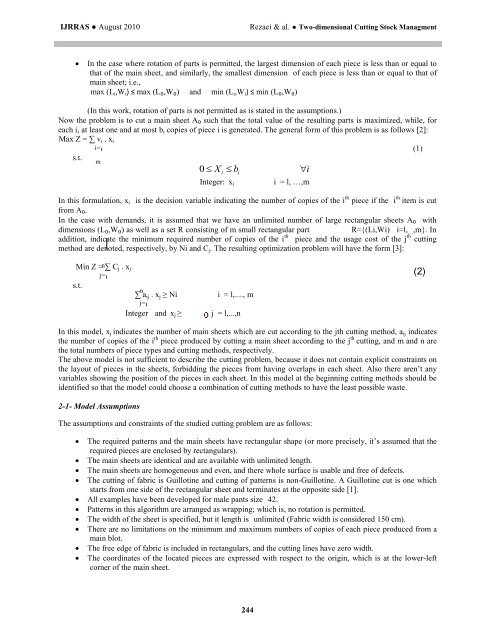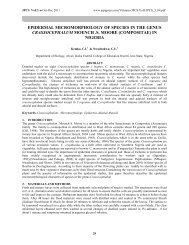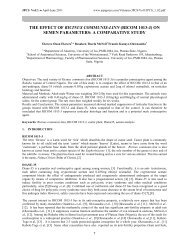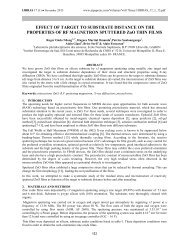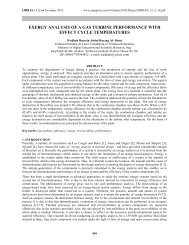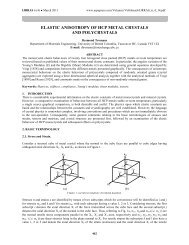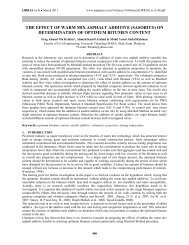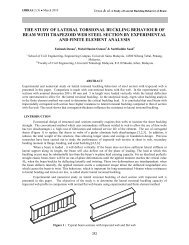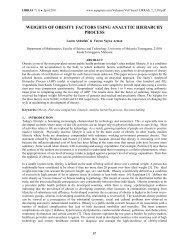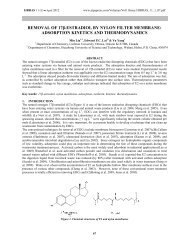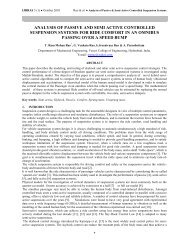Two-Dimensional Cutting Stock Management in Fabric Industries ...
Two-Dimensional Cutting Stock Management in Fabric Industries ...
Two-Dimensional Cutting Stock Management in Fabric Industries ...
Create successful ePaper yourself
Turn your PDF publications into a flip-book with our unique Google optimized e-Paper software.
IJRRAS ● August 2010 Rezaei & al. ● <strong>Two</strong>-dimensional <strong>Cutt<strong>in</strong>g</strong> <strong>Stock</strong> Managment<br />
In the case where rotation of parts is permitted, the largest dimension of each piece is less than or equal to<br />
that of the ma<strong>in</strong> sheet, and similarly, the smallest dimension of each piece is less than or equal to that of<br />
ma<strong>in</strong> sheet; i.e.,<br />
max (Li,Wi) ≤ max (L₀,W₀) and m<strong>in</strong> (Li,Wi) ≤ m<strong>in</strong> (L₀,W₀)<br />
(In this work, rotation of parts is not permitted as is stated <strong>in</strong> the assumptions.)<br />
Now the problem is to cut a ma<strong>in</strong> sheet A₀ such that the total value of the result<strong>in</strong>g parts is maximized, while, for<br />
each i, at least one and at most bi copies of piece i is generated. The general form of this problem is as follows [2]:<br />
Max Z = ∑ vi . xi<br />
s.t.<br />
0 <br />
X i bi<br />
244<br />
i<br />
Integer: xi i = l, …,m<br />
In this formulation, xi is the decision variable <strong>in</strong>dicat<strong>in</strong>g the number of copies of the i th piece if the i th item is cut<br />
from A₀.<br />
In the case with demands, it is assumed that we have an unlimited number of large rectangular sheets A₀ with<br />
dimensions (L₀,W₀) as well as a set R consist<strong>in</strong>g of m small rectangular part R={(Li,Wi) i=l,…,m}. In<br />
addition, <strong>in</strong>dicate the m<strong>in</strong>imum required number of copies of the i th piece and the usage cost of the j th cutt<strong>in</strong>g<br />
method are denoted, respectively, by Ni and Cj. The result<strong>in</strong>g optimization problem will have the form [3]:<br />
M<strong>in</strong> Z = n ∑ Cj . xj<br />
j=<br />
¹<br />
s.t.<br />
i= ¹<br />
m<br />
n<br />
∑ aij . xj ≥ Ni i = l,...., m<br />
j=<br />
¹<br />
Integer and xj ≥ j = l,...,n<br />
In this model, xj <strong>in</strong>dicates the number of ma<strong>in</strong> sheets which are cut accord<strong>in</strong>g to the jth cutt<strong>in</strong>g method, aij <strong>in</strong>dicates<br />
the number of copies of the i th piece produced by cutt<strong>in</strong>g a ma<strong>in</strong> sheet accord<strong>in</strong>g to the j th cutt<strong>in</strong>g, and m and n are<br />
the total numbers of piece types and cutt<strong>in</strong>g methods, respectively.<br />
The above model is not sufficient to describe the cutt<strong>in</strong>g problem, because it does not conta<strong>in</strong> explicit constra<strong>in</strong>ts on<br />
the layout of pieces <strong>in</strong> the sheets, forbidd<strong>in</strong>g the pieces from hav<strong>in</strong>g overlaps <strong>in</strong> each sheet. Also there aren’t any<br />
variables show<strong>in</strong>g the position of the pieces <strong>in</strong> each sheet. In this model at the beg<strong>in</strong>n<strong>in</strong>g cutt<strong>in</strong>g methods should be<br />
identified so that the model could choose a comb<strong>in</strong>ation of cutt<strong>in</strong>g methods to have the least possible waste.<br />
2-1- Model Assumptions<br />
The assumptions and constra<strong>in</strong>ts of the studied cutt<strong>in</strong>g problem are as follows:<br />
The required patterns and the ma<strong>in</strong> sheets have rectangular shape (or more precisely, it’s assumed that the<br />
required pieces are enclosed by rectangulars).<br />
The ma<strong>in</strong> sheets are identical and are available with unlimited length.<br />
The ma<strong>in</strong> sheets are homogeneous and even, and there whole surface is usable and free of defects.<br />
The cutt<strong>in</strong>g of fabric is Guillot<strong>in</strong>e and cutt<strong>in</strong>g of patterns is non-Guillot<strong>in</strong>e. A Guillot<strong>in</strong>e cut is one which<br />
starts from one side of the rectangular sheet and term<strong>in</strong>ates at the opposite side [1].<br />
All examples have been developed for male pants size 42.<br />
Patterns <strong>in</strong> this algorithm are arranged as wrapp<strong>in</strong>g; which is, no rotation is permitted.<br />
The width of the sheet is specified, but it length is unlimited (<strong>Fabric</strong> width is considered 150 cm).<br />
There are no limitations on the m<strong>in</strong>imum and maximum numbers of copies of each piece produced from a<br />
ma<strong>in</strong> blot.<br />
The free edge of fabric is <strong>in</strong>cluded <strong>in</strong> rectangulars, and the cutt<strong>in</strong>g l<strong>in</strong>es have zero width.<br />
The coord<strong>in</strong>ates of the located pieces are expressed with respect to the orig<strong>in</strong>, which is at the lower-left<br />
corner of the ma<strong>in</strong> sheet.<br />
(1)<br />
(2)


